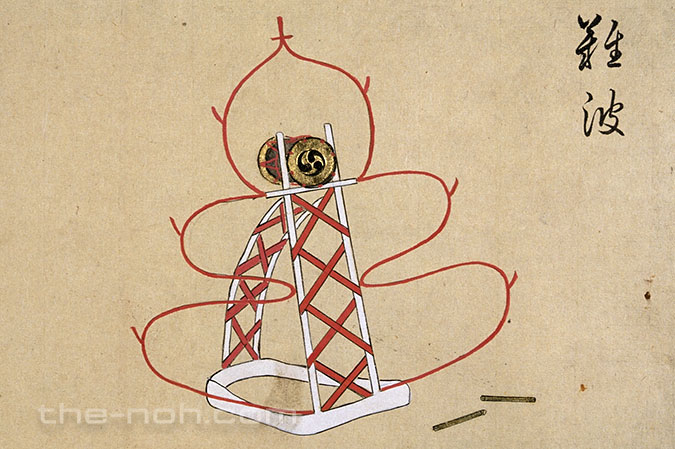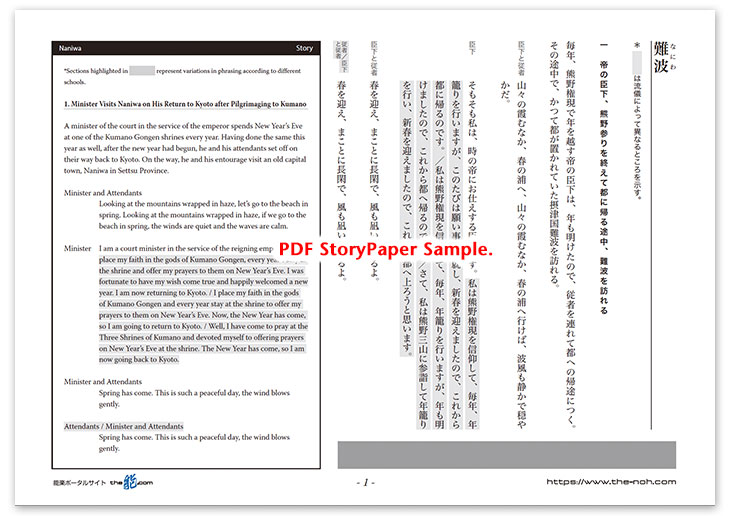
 Naniwa
Naniwa

![]()
A minister of the court, in the service of an emperor, spent his New Year’s Eve in Kumano. He stops by the village of Naniwa on his way back to Kyoto. In the village, the minister meets an old man and a young villager (a man or a woman, depending on the Noh school). Seeing them sweep and clean the ground under a well-grown plum tree in blossom, the minister asks whether the plum tree is a famous historic icon. The old man responds that the minister, who looks at the beautiful plum blossoms of Naniwa and boorishly asks if that tree is famous, must indeed lack refined sentiments and not know elegance. He then explains that since long ago, poems have been written about the plum blossoms of Naniwa. The minister admits that he asked a silly question about this being a famous tree and asks about the deeper meaning of the poem, “In Naniwa Bay, / Now the plum flowers are blooming, / After lying dormant all winter. / Spring has arrived and they are in full bloom, / These flowers.” The old man explains that the plum blossoms in the poem are an oblique reference to Emperor Nintoku, commends that emperor’s reign, and offers to play, for the minister, a piece of court music called “Shun’nōden” (“The Call of the Bush Warbler in Spring”) that describes a bush warbler alighting in a plum tree. Then, he reveals that the young villager is the spirit of the plum blossoms and the old man himself is Ōnin from Baekje in Korea. Ōnin also says that he is the author of the poem that begins, “In Naniwa Bay, / Now the plum flowers are blooming.” After promising to appear again that night, he and the young villager vanish into thin air.
Meanwhile, the spirit of the plum blossoms appears and narrates the story of relationship between Ōnin and Emperor Nintoku. He sets up a drum on the stage to prepare for a performance of court music and dance, plays a Japanese flute, performs a dance, and exits from the stage.
In the middle of the night, when the minister is drowsing off under the plum tree, the ghosts of Ōnin and Goddess Konohanasakuya-hime appear. After the goddess performs a dance, Ōnin also performs a dance and plays various court music. On top of this, Ōnin predicts that, enticed by such music, sages will appear and lead this world in peace. He lauds the reign of the emperor.
![]()
This waki-noh (literally, “side-noh”) created by Zeami was once called Naniwa no Ume (The Naniwa Plum). The lead character, Ōnin (also called Wani in Japanese history) was a scholar from Baekju (an ancient Korean kingdom) and the author of the poem about plum blossoms in Naniwa Bay. Although this play has a very simple storyline, by introducing the poem about the plum blossoms and lauding the reign of Emperor Nintoku, it conveys the elegance of traditional Japanese culture, such as Japanese waka poetry and court music and dance, that has endured since ancient times.
The main topic of this drama—the poem about the Naniwa Bay plum flowers—has been paired with the poem about Mount Asaka (which is also cited in this play). Together, these two poems have been called “the father and mother” of Japanese poetry in Kokin Waka-shū (Collection of Japanese Poems of Ancient and Modern Times). For some centuries in the past, students’ first lessons in how to properly write Japanese were to practice transcribing these two poems. Although Japanese students do not use these poems anymore to learn and practice handwriting, for the Japanese of past generations, they were required learning. In this play, the lead character, the old man (Ōnin) reproaches the supporting character, the court minister, for lacking a refined heart and elegance when he boorishly asks whether the plum tree is a famous historical icon. Ōnin reproached the minister because the poem about the plum blossoms was already widely known among the people of that time.
Several pieces of court music are introduced in the latter half of the drama, including “The Call of the Bush Warbler in Spring” (Shun’nōden) ― a song that is perfect for celebrating the arrival of spring. Although these musical pieces were originally brought from China to Japan in ancient times, as they have been gradually modified in Japan, they have been passed down to us today as traditional Japanese court music. People today still have opportunities to hear them performed.
The audience’s enjoyment of this performance of Naniwa will be augmented by deepening their appreciation of the history of Japanese poetry and court music. Conversely, we can also approach this play as one way that Noh played a role in introducing poems and musical pieces to people that, as they were widely disseminated, came to form the universal “required learning” of shared Japanese cultural heritage.
STORY PAPER : Naniwa
Story Paper presents noh chant stories in modern speech, with story outlines, highlights and more using Adobe PDF format, which can print out and zoom in. Print out the pages and take them with you when you see the actual noh performance.

The copyright of Story Paper is held by the Noh.com. Story Paper is for individual use only. It is prohibited by the copyright law to distribute or publish printed-out Story Paper pages without prior consent. For more information, check the credit and disclaimer pages.



 [Naniwa : Story Paper PDF : 614KB
[Naniwa : Story Paper PDF : 614KB